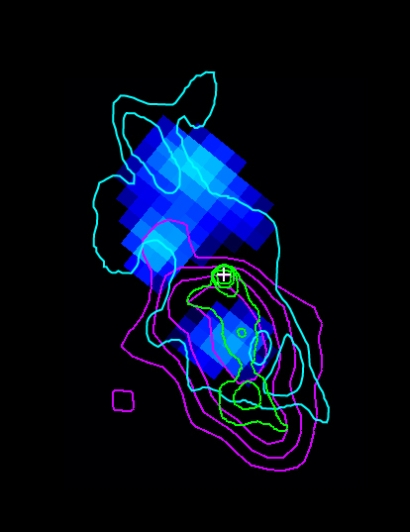
The Vela Pulsar Wind Nebula at hard X-ray energies (18 to 40 keV, blue), soft X-ray emissions (0.5 to 2 keV and 2.5 to 12 keV, green and cyan), and high energy gamma-rays (1 TeV and above, magenta). Credit: ESA/INTEGRAL/IBIS-ISGRI/F. Mattana et al./ROSAT/H.E.S.S. /Spacelab 2
Jul 11, 2013
Extreme magnetic fields in space are said to be caused by the high-speed rotation of neutron stars.
Several previous Picture of the Day articles discuss the problem of neutron stars and how they affect the progress of astronomical investigation. According to electric star theory, neutron stars belong with fantasy creatures like invisible pink unicorns. Deficits in gravity-only cosmology made the neutron star hypothesis necessary in order to defend gravity’s ostensibly endless powers.
Neutron stars are supposed to be the answer to pulsar behavior. Pulsars are stars whose brightness fluctuates over a short time span. Pulsars are important to astrophysical models because they are used as measuring tools. Those with “known” distance, coupled with variations in their luminosity, are thought to be road markers in space, so that the distances to other stars can be determined.
Pulsars are described as “light houses” with beams of energy concentrated at specific points. Consensus gravitational theory demands that a rotational mechanism is responsible for the pulsations, so when the spin of a pulsar brings its beam inline with telescopes on Earth, a flash of light is visible.
However, the rotation rates of some pulsars are found to be once per second or less (even with many times the mass of our Sun). Only a super dense material like that in a neutron star is thought sufficient to withstand those rotational speeds. Neutron star matter is a hypothetical material that has had all of its electrons smashed down into the nuclei, where the protons and electrons combine into neutrons.
According to a recent press release, the Vela pulsar is creating what astronomers call a “pulsar wind nebula (PWN)”. Using the European Southern Observatory’s (ESO) INTErnational Gamma-Ray Astrophysics Laboratory (INTEGRAL), the nebular cloud surrounding Vela has, for the first time, been mapped in hard X-ray and other frequencies.
It is said that the “…Vela pulsar gradually releases its rotational kinetic energy by driving a steady wind of highly energetic electrons and positrons. Pulsar winds create clouds of charged particles, known as pulsar wind nebulae (PWN), that radiate energy across the electromagnetic spectrum and are thus observable in several bands.”
Another magnetic beast is known as a “magnetar“. These are anomalous stars identified as X-ray pulsars (AXP) or soft gamma repeaters (SGR). They are said to be created by neutron stars with magnetic fields measuring over 10^15 Gauss. For comparison, the Earth’s magnetic field is about one-half Gauss, so these “magnetic pulsars” are surprisingly powerful sources. It must be stressed, though, that the evidence is indirect and no neutron star has ever been observed.
What is observed are intense magnetic fields sometimes pulsing in a fraction of a second. Some magnetars have also been detected emitting gamma ray bursts ascribed to “star quakes” in the ultra-hard surface of the neutron star. Because the mass per unit volume is so great, any rapid movement in the crust generates intense “magnetic reconnection,” thereby producing gamma rays.
It is not necessary to reiterate the problems with magnetic reconnection except to say that it is also one of the class of imaginary constructs created by astrophysicists in an attempt to explain energetic events without sufficient gravity
It is a well-established fact that magnetic fields are induced by electric currents. Therefore, there must be an electric current generating the intense fields in the magnetar. It is also indisputable that the feeder current must be part of a circuit, since persistent electric current must flow in a completed circuit.
The Electric Universe hypothesis requires no collapsed stars or rotational speeds so great that ordinary matter could never take the strain. The oscillations in magnetars (or pulsars, in general) are caused by resonant effects in electric circuits. The sudden release of stored electrical energy in a “double layer” is responsible for the occasional outburst of gamma rays. The outburst begins with a sudden peak of energy, and then declines gradually, like a stroke of lightning.
Don Scott, author of The Electric Sky, recently wrote: “The ‘neutron star’ is simply yet another fantasy conjured up, this time, in order to avoid confronting the idea that pulsar discharges are electrical phenomena. A nucleus or charge free atom made up of only neutrons has never been synthesized in any laboratory nor can it ever be. In fact, a web search on the word ‘neutronium’ will produce only references to a computer game—not to any real, scientific discussion or description. Lone neutrons decay into proton/electron pairs in less than 14 minutes; atom-like collections of two or more neutrons will fly apart almost instantaneously.”
It seems more likely that magnetars and PWNs are immense concentrations of electricity focused by some kind of “plasma gun” phenomenon.
Stephen Smith












